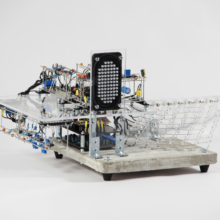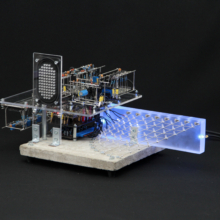folundr
electronic sound and light sculpture, 2021
+12V, external power supply
400mm x 300mm x 200mm
folundr is a standalone generative sound and light sculpture controlled by a ESP32, which randomly creates and morphs sequences of notes over time. The sound production itself is entirely analog, consisting of two oscillators, two parallel -12dB/oct low pass filters, two voltage controlled amplifiers and delay. The patterns on the LED matrix are generated by interpolating between various points as the pitches of the oscillators change.
folundr was created on the premise of making what is essentially self-contained, self-patching synthesizers that require no human input to function. It continues a series of other such works which uses microcontrollers to control analog circuitry with DACs, in this case, ESP32 and MCP4822s sending control voltages to AS3330, AS3340 and AS3350 chips (VCA, VCO and dual VCF respectively).
Under the hood, the ESP32 contains a vast amount of arrays accounting to different musical scales, which can be loaded from the memory and into empty arrays, to the same effect as quantizers in more regular synthesizers. The music is then formed by looping a set of notes, or sequences, with a minor chance of changing either the pitch of any note in the sequence, changing the length of the sequence, or changing the rate of how quickly you run through the sequence, thus over time changing the entire ‘piece’, as it were.
The project uses a single +12Vdc, 500mA external adapter which then is split into +12V, -12V and +5V (using a 7660SCPAZ to invert +12 to -12 (take note of the suffix, as it’s the only variant of the 7660 which allows you to ‘boost’ the clock frequency and take it out of the audio range, severely reducing noise)) to supply various parts of the project. The analog circuitry is built freeform on the top of the sculpture, while most of the digital circuitry (ESP32, LED drivers) is somewhat hidden underneath, using regular prototyping boards.
Structural elements include acrylic glass, concrete, stainless steel spacers, and tinned copper wire for electrical parts.




